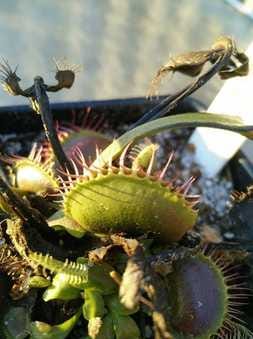GROWING DIONAEA MUSCIPULA
Introduction
Dionaea muscipula is the sole member of the monotypic genus Dionaea, known commonly as the Venus Flytrap. It is naturally restricted to a few sites in the coastal plains of southeastern North Carolina and northeastern South Carolina (although some populations have been naturalized in Florida and other places by hobbyists). The plant is easy to maintain in cultivation given that a few basic requirements are met, the most important of these being as much light as possible, a winter dormancy period, and pure water. It is really impossible to overstress how important light is to this plant. Almost all VFT deaths at the hands of neophytes may be traced back to issues related to lack of light. THIS PLANT IS NOT SUITABLE FOR A TERRARIUM WITH A SINGLE DINKY LIGHT BULB! The excess humidity is not necessary and the plant will be much happier outdoors where it can get full sun and the proper seasonal cues. Windowsill growing is also not recommended unless you have absolutely no place to put your plants outside.
A Few Notes on Cultivation
The internet is already full of grow guides for VFTs (some are much more accurate than others; I recommend the ones over at the International Carnivorous Plant Society and FlytrapCare sites), so I won't spend time addressing common questions that have been answered elsewhere. In USDA zone 6b where I live, I have found it necessary to mulch the plants with a thick layer of pine needles to protect them from desiccating winds and freeze-drying. It is advisable to keep the plants only slightly moist during dormancy in places with milder winters, but since my plants spend most of the winter frozen under 2' of pine needles I don't worry about that too much. People who live in colder climates will likely have to go to extra means to protect their plants. The plants depend heavily on the changing photoperiod to tell them when to begin entering and exiting dormancy, so take advantage of the automatic timer available outside!
I have not observed a strong preference for either Sphagnum-based or peat-based media. I prefer growing mine in 1:1 peat/sand since it breaks down much more slowly and makes repotting easier. I have heard people say that they tend to rot easily if kept too wet, but I have noticed that in full sun, the plants do not mind the moisture level too much as long as the rhizome is not submerged. Rot only tends to become an issue when there is insufficient light.
Other growers report that some cultivars (such as 'Gremlin', etc.) are more vigorous or cold hardy than others like 'Bohemian Garnet' etc. Neither of us are hugely into VFTs so we don't have much to contribute to this conversation, other than that with maybe a few minor exceptions, all the various cultivars can be grown pretty much identically.


